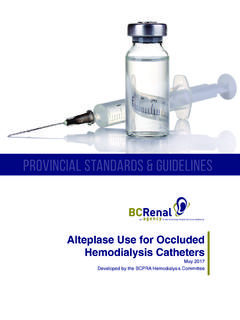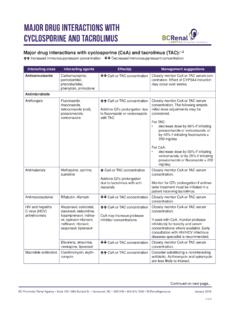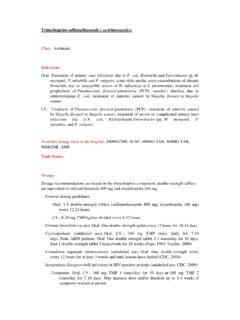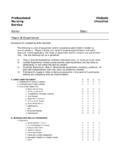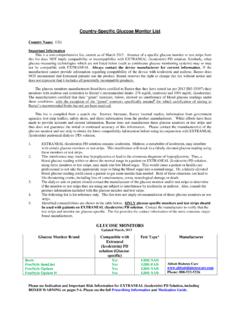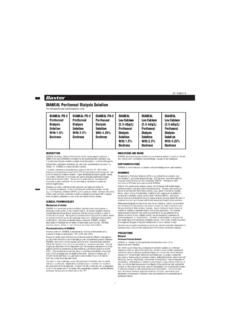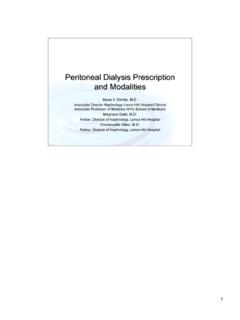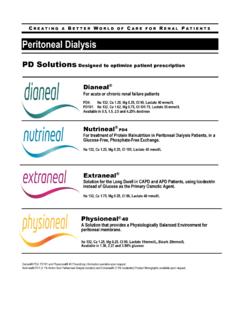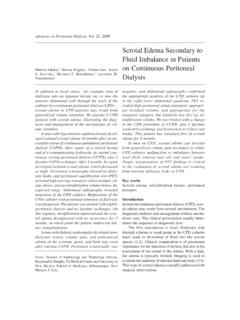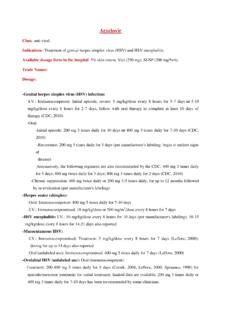Transcription of PROVINCIAL STANDARDS & GUIDELINES
1 NxStage Nursing Manual Created: August 2015 Revised: December 2016 Approved by the Home Hemodialysis Committee PROVINCIAL STANDARDS & GUIDELINEST able of ContentsIntroduction .. NxStage Dialysate .. Dialysate rate and volume .. Extracorporeal Circuit .. Cartridges .. System Settings .. Anticoagulation .. Flow Fraction .. Blood Flow .. Alarms .. Giving Medications .. Transonic .. Pureflow SL and Water Testing .. References ..13 Appendix 1: Home Hemodialysis NxStage Machine Selection Tool ..14 Appendix 2: NxStage Heparin Protocol ..15 Appendix 3: Quick Reference Card to the MedFusion 3500 Syringe Pump.
2 21 Appendix 4: HHD Home Assessment and Water Results ..23 @BCRenalAgency IMPORTANT INFORMATIONThis BCPRA guideline/resource was developed to support equitable, best practice care for patients with chronic kidney disease living in BC. The guideline/resource promotes standardized practices and is intended to assist renal programs in providing care that is reflected in quality patient outcome measurements. Based on the best information available at the time of publication, this guideline/resource relies on evidence and avoids opinion-based statements where possible; refer to for the most recent version.
3 For information about the use and referencing of BCPRA PROVINCIAL GUIDELINES /resources, refer to !BC PROVINCIAL Renal Agency Suite 700-1380 Burrard St. Vancouver, BC V6Z 2H3 January 20173 IntroductionExpansion of Home Hemodialysis ProgramThe BC PROVINCIAL Renal Agency (BCPRA) and the health authority renal programs have operated a single home hemodialysis machine program, initially using the Gambro AK 95 and then the Baxter/Gambro AK 96 hemodialysis machine. These machines have provided high quality dialysis treatments and patients have been well supported in their BCPRA is expanding its home hemodialysis program by introducing a new home hemodialysis machine.
4 The NxStage home hemodialysis machine will not replace the current Baxter/Gambro hemodialysis machine. The goal of a two machine model is to expand home hemodialysis to a wider group of patients and to increase overall numbers of patients who may benefit from home dialysis in BC. Therefore, a machine selection tool has been created to assist programs in assessing the need for a NxStage machine. To be considered for NxStage, certain clinical considerations must be met. Please complete the Appendix 1: NxStage Machine Selection Tool. NxStage BackgroundIn conventional, high efficiency hemodialysis, the objective is to deliver as much therapy (and clearance) in a minimum 4 hours, 3 times a week.
5 With this objective, high efficiency refers to clearance per unit TIME. As a result, conventional dialysis uses large volumes of water to achieve targeted therapy achieves clearance by using dwell time of the dialysate in the dialyzer itself. This occurs when the blood flow is high in relation to the dialysate flow. Dialysate saturation exceeds 90% when blood flow is 3 or more times the dialysate flow. When dialysate saturation approaches 100%, the treatment dose approximates clearance treatment time and is approximately equal to the volume of dialysate exchanges. Similar to PD, dosing is expressed in the volume of Nursing ManualBC PROVINCIAL Renal Agency Suite 700-1380 Burrard St.
6 Vancouver, BC V6Z 2H3 January 20174 DialysateDialysate CompositionThere are limited options for altering the electrolyte content of the dialysate. The composition of dialysate is: Lactate 40 or 45 mEq/LPotassium mEq/L or mEq/LSodium 140 mEq/LCalcium mEq/LMagnesium mEq/LChloride 105 mEq/LDextrose 100 mg/dL Water Purification Pak Pureflow SL Dialysate Sak Pureflow SL is designed to incorporate all water purification and the dialysate mixing elements into one integrated SL generates dialysate 40, 50 and 60 litre batches from pre-packed concentrate that must be used within 72 hours of initiation of production.
7 There is approximately 250mls of overfill to allow for setup. NxStage does not use glucose as the osmotic fluid removal agent- all new ultrafiltration is pressure driven (versus osmotic).Lactate-Based DialysateMost conventional hemodialysis machines use bicarbonate-based dialysate. Therapies using prepackaged fluid, like PD and NxStage, use lactate-based dialysate. Lactate is more amenable than bicarbonate because it will not precipitate and therefore has longer shelf stability. Lactate is converted by the patient rapidly into bicarbonate (primary by the liver) but also by the skeletal lactate formulations include 40 and 45 mEq/L.
8 Target pre-treatment bicarbonate levels of 22-25 is a 50% larger molecule than bicarbonate and thus the rate at which it diffuses across the dialyzer membrane is slightly lower. A higher concentration helps to ensure adequate buffer replenishment. Therapy on NxStage leads to a higher elevation of serum lactate at the end of treatment, which returns to baseline levels soon after produced lactate associated with anaerobic status ( , shock) can be critical to the patient. This is not the case with the lactate buffer as levels will return to normal in a few hours post is possible that some patients ( liver failure) may not be able to adequately convert lactate to NxStage Nursing ManualBC PROVINCIAL Renal Agency Suite 700-1380 Burrard St.
9 Vancouver, BC V6Z 2H3 January 20175bicarbonate in a timely basis. Patients subject to this risk should be followed closely. Failure to convert lactate would likely manifest as:a) A persistent acidotic stateb) A measurable sustained elevation of plasma lactate levelsDialysate TempThe dialysate temp will be cooler if the ambient temperature is cooler. The warming system is based on numbers, ranging from 12 (cooler) to 20 (warmer). Please note: the PureFlow SL will only alarm and go into bypass if the dialysate temperature is low at ~ C or high at ~43 C.
10 Check the dialysate temperature with your hand prior to each dialysis. Do not unplug or move the machine after production of the dialysate, as the warmer will not heat the dialysate. If the machine was unplugged overnight, do not use the dialysate. It will be too cold for the patient. The machine will not alarm to warn you of Dialysate Rate and VolumeThe dialysate flow rate is set lower than conventional machine as the flow rate is to theoretically maximize the dialysate at a 100% efficiency. The maximum dialysate flow rate for the NxStage machine is dialysate volume refers to the amount of prescribed dialysate to be used per dialysis treatment.

